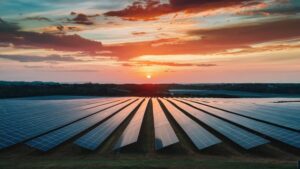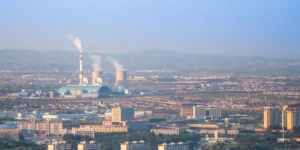Sinovoltaics promises panel perfection or your money back


EL imaging being performed at a solar farm (courtesy: Sinovoltaics)
It’s never easy being the new guy in town, especially when your job is to critique the work of others.
But Sinovoltaics isn’t expanding into the United States to make friends; the pre-shipment quality assurance company is coming here to inspect solar panels. All of them.
“For us, it’s a big deal to come here, and we’re super excited to go to the biggest market in the Western world,” beams head of technology Arthur Claire. “We’re really proud.”
Claire, a glasses-donning Frenchman with an easy smile, is visiting sunny San Diego, California to spread the news of Sinovoltaics coming stateside. He laments the fact that there aren’t free beers and Bavarian pretzels on the Intersolar show floor (make that two of us, I’m a sucker for pretzels). Claire got his start working in the semiconductors business in Asia, ultimately moving into energy storage and then quality assurance to more closely mirror his values. He might not be done jumping around.
“I am working for an inspection company but I don’t like inspection companies,” he offers.
Oh, do tell.
Having some skin in the game
Most quality assurance companies randomly sample photovoltaic modules and test them for flaws using electroluminescence techniques- hitting PV panels with light to see what shines through. On a typical 10 MW project, that might mean 125 units are inspected. Sinovoltaics is changing the standard by taking a close look at every single module.
But wait, there’s more. Rather than serve as an intermediary with no real vested interest in a project, Sinovoltaics offers what it calls “Zero Risk Solar” service. Using a proprietary AI-driven tool, SELMA (Sinovoltaics Electroluminescence Mass Analysis) inspects 100% of purchased modules for microcracks and other defects, allowing the company to promise pre-shipment perfection. The software is up to 99% accurate.

“I think we’re really different in that way that we really care about the performance of the site,” Claire explains. “Because we do 100% testing, we should have some skin in the game.”
Since 2020, SELMA has been implemented at all major Tier 1 solar manufacturers. Last year alone, more than 4 million PV modules were inspected. Replacement rates of 1-3% were common at Tier 1 factories, preventing hundreds of thousands of defective PV modules from being shipped.
If any of the procured modules are messed up, the developer of a project isn’t hung out to dry. They can file a claim within three years and Sinovoltaics will pay liquidated damages to cover costs including de-assembly, manpower, and logistics. The service is underwritten by global insurance giant Munich RE, providing a modicum of security to financiers in an often tumultuous investment space.
“This is our secret sauce for sure,” Claire details. “Our European clients love it… I’m pretty sure that in the U.S. it’s going to be really well received.”
Coming to America
The Sinovoltaics footprint is already an impressive collection of Where in the World is Carmen San Diego? locales. The company maintains offices in Switzerland, the United States, Hong Kong, Mainland China, Vietnam, and Spain; factory inspection and audit teams are strategically located in Vietnam, Turkey, Thailand, China, Malaysia, Cambodia, South Korea, India, and elsewhere.
But why the United States? And why now?
Massive investments in renewable energy spurred by the IRA and other legislation make the marketplace a much more active one for companies like Sinovoltaics. It’s also worth noting President Biden’s two-year moratorium on new tariffs on solar imports expires in June.

The U.S. Sinovoltaics team will be small to start. Three employees as of this week, each in different time zones. It’s a knife fight to determine which one is the “headquarters.”
“It’s not a secret if I tell you that we want to have more business here,” Claire admits. He’s excited about new factories cropping up across North America and expects the company’s presence to grow.
“It’s super interesting for us right now because we have a small team in the U.S. to do this,” he adds. “We would expect for the new factories being built a couple of years from now to have a much bigger team doing audits that will be equivalent inside to our Chinese team.”
Ultimately, Sinovoltaics’ success on American shores will be determined by the quality and consistency of its inspections. Having a proprietary tool as game-changing as SELMA will help with that, as will endearing itself to American companies working on solar and storage projects.
“We don’t care if we build the biggest project in terms of megawatts,” Claire says. “We really care about the number of KW and MW hour sets generated from that. Our clients see value in ensuring that their projects perform for 10, 20, 30 years. That’s why they use our services.”




